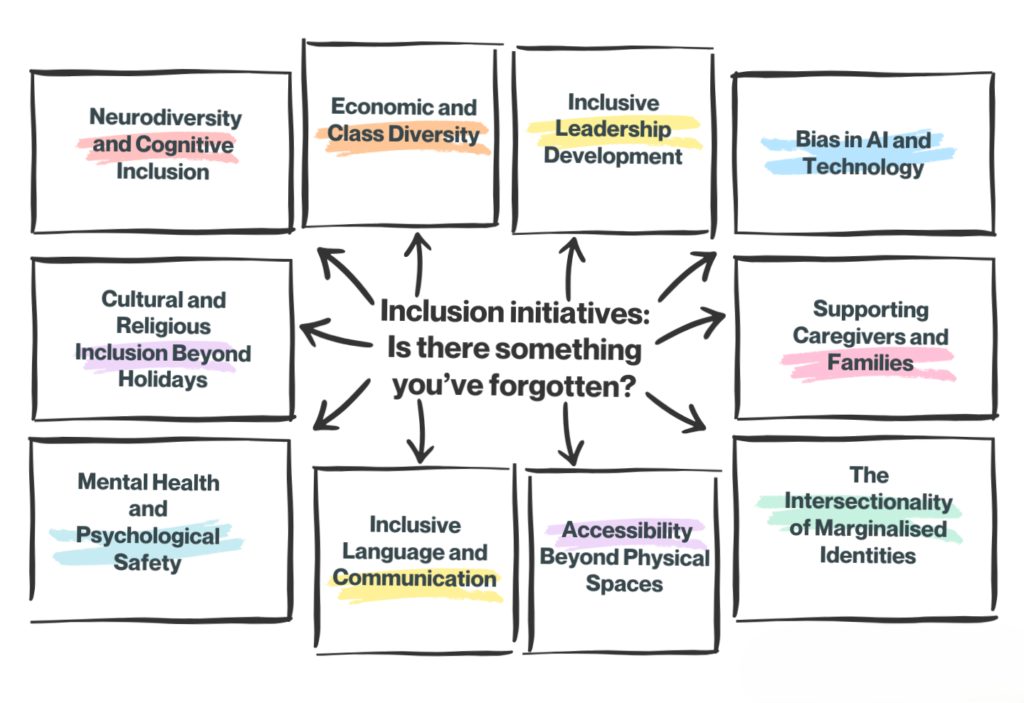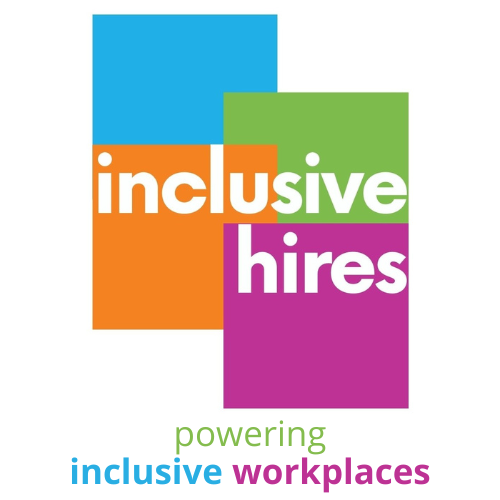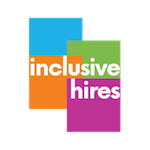
Ok, so you’re putting in the work, and your intentions are good… but is there something you’re overlooking when it comes to inclusion in the workplace that’s lessening the impact of your EDI initiatives?
When discussing workplace inclusion, the focus typically centres on factors like gender diversity and race, or physical accessibility. These are, of course, absolutely crucial, but they represent only part of the broader inclusion piece. There are several aspects that people often overlook or don’t talk about enough. These areas are vital to fostering truly inclusive environments but may not receive the same attention as more common challenges.
The theme of this year’s National Inclusion Week 2024 (September 23rd-29th) is ‘Impact Matters’. In support of this, here are some examples of how you can make more of an inclusive impact in your organisation:
1. Neurodiversity and Cognitive Inclusion
While companies often focus on visible diversity, they may neglect neurodiversity, which includes individuals with autism, ADHD, dyslexia, and other cognitive differences. Neurodivergent individuals bring unique strengths to the workplace and this needs to be acknowledged and celebrated. Creating inclusive spaces for neurodivergent employees involves rethinking communication styles, office environments, and workflow processes to suit and embrace different cognitive styles.
2. Economic and Class Diversity
Discussions around diversity tend to focus on race, gender, and sometimes age, but socio-economic backgrounds often get left out. Employees from lower-income backgrounds might face hidden challenges, including networking difficulties, a lack of financial security, or subtle biases in corporate cultures that reward certain privileges. Addressing this requires more than just wage equality; it involves creating pathways for those from disadvantaged backgrounds to thrive in workspaces that are traditionally dominated by the middle and upper class.
3. Inclusive Leadership Development
Most diversity and inclusion programmes focus on entry-level and mid-level hiring, but less attention is paid to how inclusive practices can be incorporated into leadership pipelines. Often, those who make it to leadership roles have benefitted from privilege, sponsorship, and mentorship opportunities that aren’t accessible to everyone. Creating more equitable systems for leadership development—such as mentorship programmes specifically designed for underrepresented groups—can help foster truly diverse leadership teams.
4. Cultural and Religious Inclusion Beyond Holidays
While many workplaces recognise major religious holidays and cultural celebrations, deeper understanding and accommodation of diverse cultural practices are often overlooked. This includes things like allowing for flexible work hours to accommodate prayer times, dietary restrictions at work events, and being mindful of cultural communication styles. Ensuring that people feel their cultural identities are respected daily—not just during a holiday—builds a more inclusive environment.
5. Mental Health and Psychological Safety
Inclusive workplaces should also address mental health openly, but many companies only touch on this lightly, if at all. Fostering psychological safety—where employees feel safe to express ideas, concerns, and feelings without fear of retaliation—is crucial for an inclusive culture. This involves not only providing mental health resources but also creating a culture that de-stigmatises mental health struggles, encourages open conversations, and allows employees to thrive without fear of judgment or exclusion.
6. The Intersectionality of Marginalised Identities
Intersectionality—the idea that people can experience multiple overlapping forms of discrimination (e.g., being a woman of colour who is also disabled)—is often ignored. Conversations around inclusion may focus on one dimension of diversity at a time, neglecting the compounded challenges that arise when multiple marginalised identities intersect. Inclusive workplaces should consider policies that address the unique challenges of those who occupy more than one marginalised identity.
7. Bias in AI and Technology
As workplaces increasingly rely on AI-driven tools for recruitment, performance tracking, and even decision-making, there is not enough attention on the biases these technologies can perpetuate. AI systems can reinforce biases based on the data they’re trained on, potentially disadvantaging minority candidates or perpetuating stereotypes. Organisations must prioritise fairness in their tech systems to ensure inclusivity at a structural level.
8. Inclusive Language and Communication
The language used in the workplace can shape its inclusivity, yet this is often overlooked in discussions. Microaggressions, assumptions, and exclusionary language can alienate certain groups. Additionally, businesses sometimes fail to address communication barriers for employees who may not be native speakers of the dominant language. Cultivating a culture of inclusive language that considers tone, assumptions, and accessibility is crucial.
9. Supporting Caregivers and Families
Workplaces often overlook the specific needs of caregivers, whether they are parents or individuals caring for elderly or disabled family members. Flexibility, parental leave policies, and understanding around caregiving responsibilities are important, but they are not always provided or normalised in workplaces. Inclusive workplaces recognise that caregiving is a shared societal responsibility and support employees in balancing work and caregiving demands.
10. Accessibility Beyond Physical Spaces
When we talk about inclusion for people with disabilities, the conversation often stops at physical accessibility (ramps, lifts, etc.). However, digital accessibility, such as making sure all online platforms are usable by people with visual or hearing impairments, is just as important, and often overlooked. Ensuring all materials, systems, and processes are accessible to everyone can transform a workplace into a truly inclusive environment for people with disabilities.
Download an infographic of our ’10 Often Overlooked Drivers of Workplace Inclusion’ here >>>
Addressing these less-discussed aspects will help create a more impactful approach to building truly inclusive workplaces that goes beyond token gestures or surface-level policies.

~ Inclusive Recruiting
Continued conversations nurture better understanding and allyship. We can help you facilitate these conversations and help you take a more impactful approach to building a truly inclusive workplace!
Sign your team up today for our one of our inclusion training workshops.

